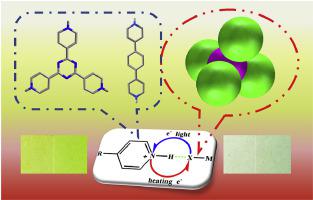Dyes and Pigments ( IF 4.1 ) Pub Date : 2020-08-20 , DOI: 10.1016/j.dyepig.2020.108784 Xiao-Fan Jiang , Yu-Juan Ma , Bang-Di Ge , Song-De Han , Jin-Hua Li , Guo-Ming Wang

|
Photochromic materials have application in various areas such as anti-counterfeiting, display, switches, etc. Most of reported photochromic materials are supported by photoactive moieties such as diarylethenes, pyridinium, azo compounds. Compared with the broadly investigated photochromic materials driven by photoactive units, the generation of new photochromic materials based on nonphotoactive units is of paramount significance from the perspective of basic research and practical application. Based on the proton coupled electron transfer (PCET) mechanism, the introduction of conjugated triangular tripyridine-derivative unit TPT (2,4,6-tri(4-pyridyl)-1,3,5-triazine) and linear dipyridine-derivative unit BPYB (1,4-di(pyridine-4-yl)benzene) into the zincochloride system generates two hybrid halometallates with photochromic performance, [H2BPYB][ZnCl4]·H2O (1) and [H3TPT]2[Zn3Cl12]·4H2O (2). Both 1 and 2 feature isolated inorganic [ZnCl4]2− tetrahedra (as electron donors and H-bond acceptors) and protonated organic polypyridine derivatives units [H2BPYB]2+ and [H3TPT]3+ (as electron acceptors and H-bond donors). Experimental characterization, together with the structure-property relationship analysis, indicates that the resulting photocoloration and related photoresponsive properties of 1 and 2 is ascribable to the PCET mechanism.
中文翻译:

基于非光敏聚吡啶衍生物部分的晶体杂化光致变色卤代金属盐的设计和构建的质子耦合电子转移机理
光致变色材料已在防伪,显示,开关等各个领域得到应用。大多数报道的光致变色材料均由光活性部分(如二芳烃,吡啶鎓,偶氮化合物)支撑。与广泛研究的由光敏单元驱动的光致变色材料相比,从基础研究和实际应用的角度来看,基于非光敏单元的新型光致变色材料的产生至关重要。基于质子偶联电子转移(PCET)机理,引入了共轭三角三吡啶衍生物TPT(2,4,6-三(4-吡啶基)-1,3,5-三嗪)和线性二吡啶衍生物单元BPYB(1,4-二(吡啶-4-基)苯)进入氯化锌体系,生成两种具有光致变色性能的杂化卤化金属盐,[H2 BPYB] [ZnCl 4 ]·H 2 O(1)和[H 3 TPT] 2 [Zn 3 Cl 12 ]·4H 2 O(2)。既1和2的特征分离无机[氯化锌4 ] 2 -四面体(作为电子供体和氢键受体)和质子化的有机聚吡啶衍生物单元[H 2 BPYB] 2+和[H 3 TPT] 3+(作为电子受体和氢键供体)。实验表征以及结构-特性关系分析表明,所得的1和2的光致变色和相关的光响应特性归因于PCET机制。













































 京公网安备 11010802027423号
京公网安备 11010802027423号